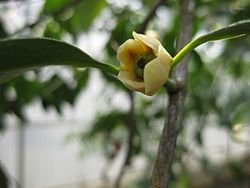Cowa-কাউ

Kau or Kaupl (English: Cowa (mangosteen) or mangostin; Scientific name Garcinia cowa Roxb or Garcinia kydia Roxb. [1] A kind of obsolete talk The other names are Kawa, Kaglichu, Tahgala, Kafal, Kaul-Goola etc. Its trees are medium-sized trees, low in stems and bouncing upwards. The color of the tree is black. This tree is usually seen in the jungle. The fruits are green and pale orange or yellow in raw condition. There are four or five grains in the fruit. There is a bunch of cereals with granules, which is used to suck. The fruit is not popular because it plays a pungent odor. The size of the fruit is equal to litch or slightly larger.
There are no trees in Bangladesh, India, Malaysia, South China, Laos, Cambodia, Vietnam etc. In addition to eating directly as a result, jam was made with somebody. The colors and varnishes are made from the tree trunk.
Any tree bark is used for hemorrhoids and for herbs and headache.
In the medium-sized evergreens, the tree is somewhat black-colored. Although the lower stalks are lower, they are surrounded by flimsy leaves. The flowers on the tree in December-January. The fruit is in June-July. The fruit is round, a lot of table tennis shapes but grooves. Green in green, the fruit is pale yellow or orange color. There are four or five grains inside the fruit. After harvesting these grains are to be eaten. These seeds of seeds are crepe and delicious. Apart from eating fruits as well as jam-jali can also be preserved. This fruit, filled with nutrients, is particularly effective in nourishing cold and cold. Apart from this, it removes dehydration. This tree is used to make stem and varnish. The beneficial fruit is the English name Cowa and the scientific name Garcinia cowa. There is a lot of cauliflower in the country. However, Sylhet, Maulvi Bazar, Khagrachharhi and Rangamati kaupalam more matches. This fruit is also grown in Pirojpur and Bagerhat regions. Many householders hooded people to plant two trees. As a result, the cultivars of Kaupal are also produced in the nurseries in the coastal areas. But it does not have commercial cultivation. There is a lot of demand for caulf in the market. Rice quails are sold at Tk 70-80 per kg.
